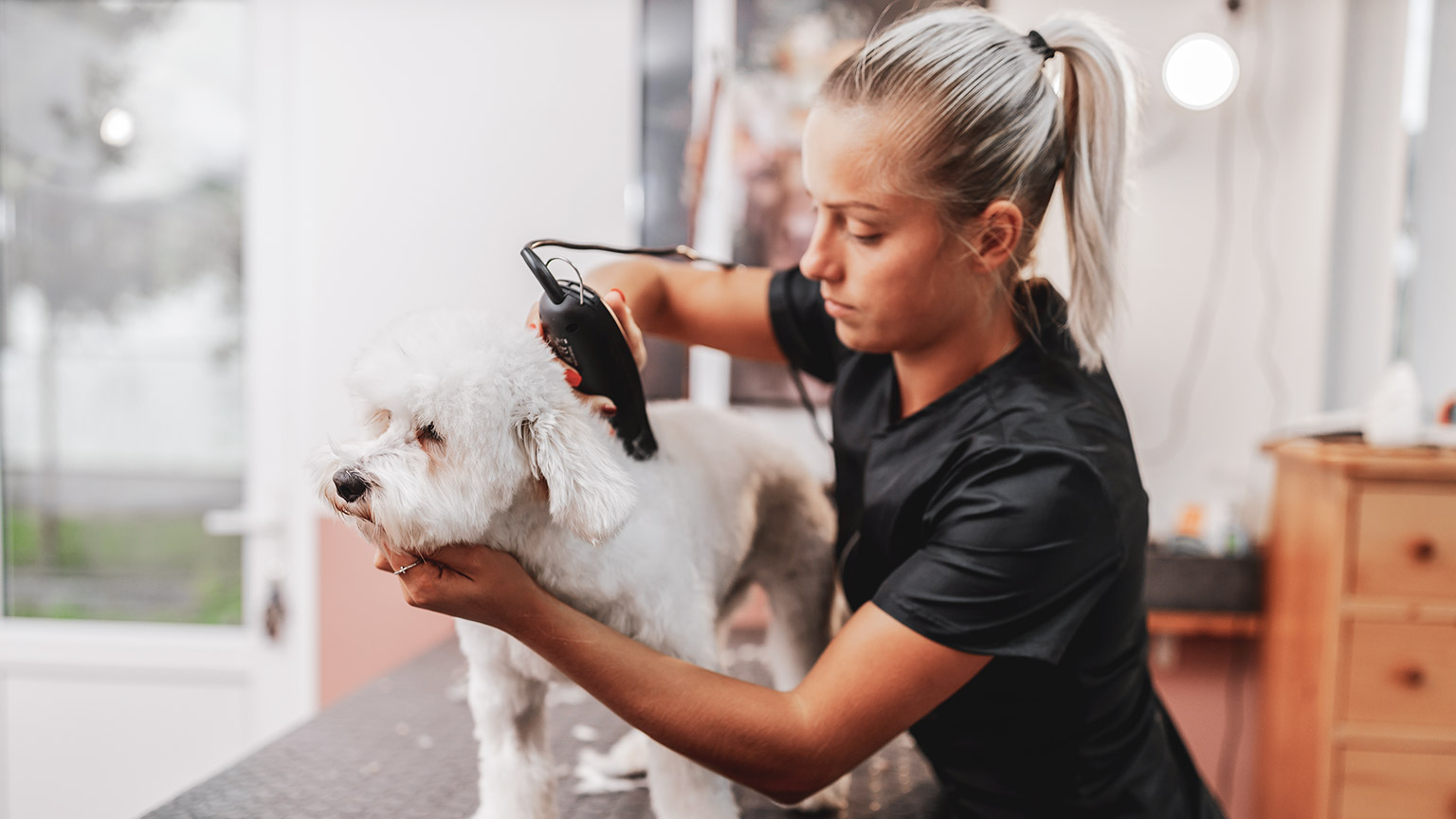What is your desired career in the animal care industry?
The animal care industry covers many sectors and within those sectors, there are a variety of job roles and potential places of employment. Qualifications required for these types of employment will vary depending on the complexity of the position. For example, certain jobs will require a university degree, such as a veterinarian, whereas others may only require a vocational certificate level course or perhaps only relevant on-the-job experience.
Activity – Hei Mahi
Look at the sectors in the diagram above. Match each sector with its description by dragging the correct sector card to the box by each description. Even if you are not sure, there should be enough clues in the sector names to help you.
H5P here
Are any of these sectors that you have thought about before as a possible career pathway? It may be worth making a note of them to help you with your future career plans.
Animal Care Sector Roles
Let’s focus just on the companion animal sector and the kinds of jobs that are available.
Pet Store / Retail Assistant
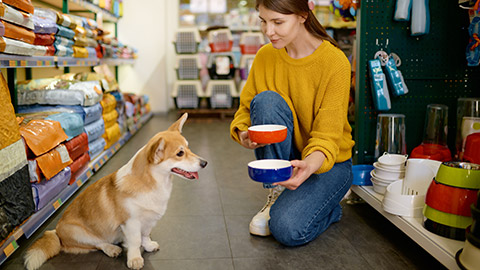
People working in a pet shop or produce store are working in a retail environment. In addition to selling a large variety of different companion animal care products, they may also sell live animals and provide advice on their care. This means a broad base of knowledge is required about the animals and products that are available. If the pet shop sells animals, retail attendants need to know how to safely handle and care for each species and be able to communicate effectively with customers to tell them about dietary requirements, housing, and potential health issues.
Boarding Kennels / Cattery Attendant
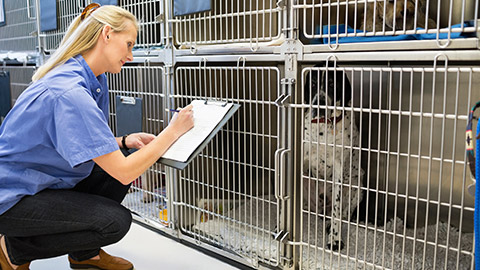
Boarding facilities, such as kennels and catteries, employ staff to clean, feed and exercise animals in their care. These staff are often referred to as kennel/boarding attendants. A boarding attendant is responsible for ensuring animals are cared for while owners are away from home. Dogs and cats in these situations are often highly stressed and may require personalised care to help them adjust to the boarding environment.
Groomers

Groomers work in grooming parlours, mobile grooming units, and also in some veterinary clinics. Duties may include brushing coats, washing, drying, and clipping/styling. Groomers work mostly with dogs; however, may also be asked to groom other animals, such as cats and rabbits. If working from a mobile grooming unit, you would need to hold a driver's license and have the appropriate insurance. It would also be important to understand the legislation regarding the disposal of water and chemicals once finished with clients and their pets.
Pet Sitters / Dog Walkers
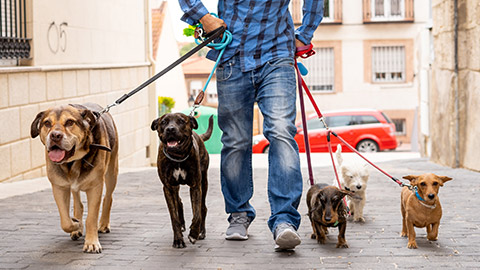
Pet sitting usually involves a sitter travelling to an owner's house on either a daily basis or staying overnight to look after the pet/s while the owners are away. A variation of in-house pet sitting is the concept of pet daycare. Pets are left at a pet sitter's house or potentially a commercial facility to be cared for by staff daily, returning to their owner's home each night. Dog walking may or may not be included in the price of pet sitting. Alternatively, dog walking services may be provided daily, especially in large urban environments for busy owners.
Reflection
Which role appeals most to you? Take a moment to rank them according to your own preference. You may already have a clear idea, but exercises like this one can clarify your options for you and help you make a career plan.
Work tasks in Animal Care Industry Roles
Work tasks are the roles and responsibilities each employee is required to perform in their job. If an employee is unclear of their tasks, they can access their job description through their staff handout/ induction or complete further on-the-job training.
There are various factors which impact when work tasks need to be carried out. Some of these include:
Timing
This could depend on the time of day, month, or year. It could also contribute to the productivity and demand of the company. Workplaces like animal shelters will be busy all year round but may be particularly busy during holiday times or peak breeding season. Retail stores are likely to need more staffing during the Christmas season, but dog-walking businesses may find that Christmas and school holidays are quieter periods because people are at home with their animals.
The role within the organisation
Smaller organisations may require an employee to take on a wider scope of roles, while in bigger organisations, roles may be specific to each set department. This means each employee would only be responsible for the tasks that are more relevant and focused to them and limits time on duties that may be administrative or irrelevant.
The type of industry
The type of industry would also change your work tasks; e.g. your tasks would be slightly different if you were working at a veterinary clinic versus working at an animal shelter.
The type of workplace
Each workplace has a unique approach to the way that tasks are completed, which is why there is an orientation/induction process that occurs at the commencement of employment. It could be that the steps for handling/ restraining a pet may be slightly different or that the recommended medications for pets are a totally different brand to what you are used to seeing on the counters. It may take some time to change your ways if you have been at a previous workplace for a lengthy amount of time, but it is important to follow the policies and procedures of the workplace you work at to ensure you are abiding by the same rules which apply to everyone else.
Kai is thinking about getting some work experience. They are not ready for a full time role yet, but they think that a part time volunteer role might be a good way of managing their anxiety. Hop Haven Rabbit Shelter has advertised for volunteers.
Case Study
Hop Haven Rabbit Shelter
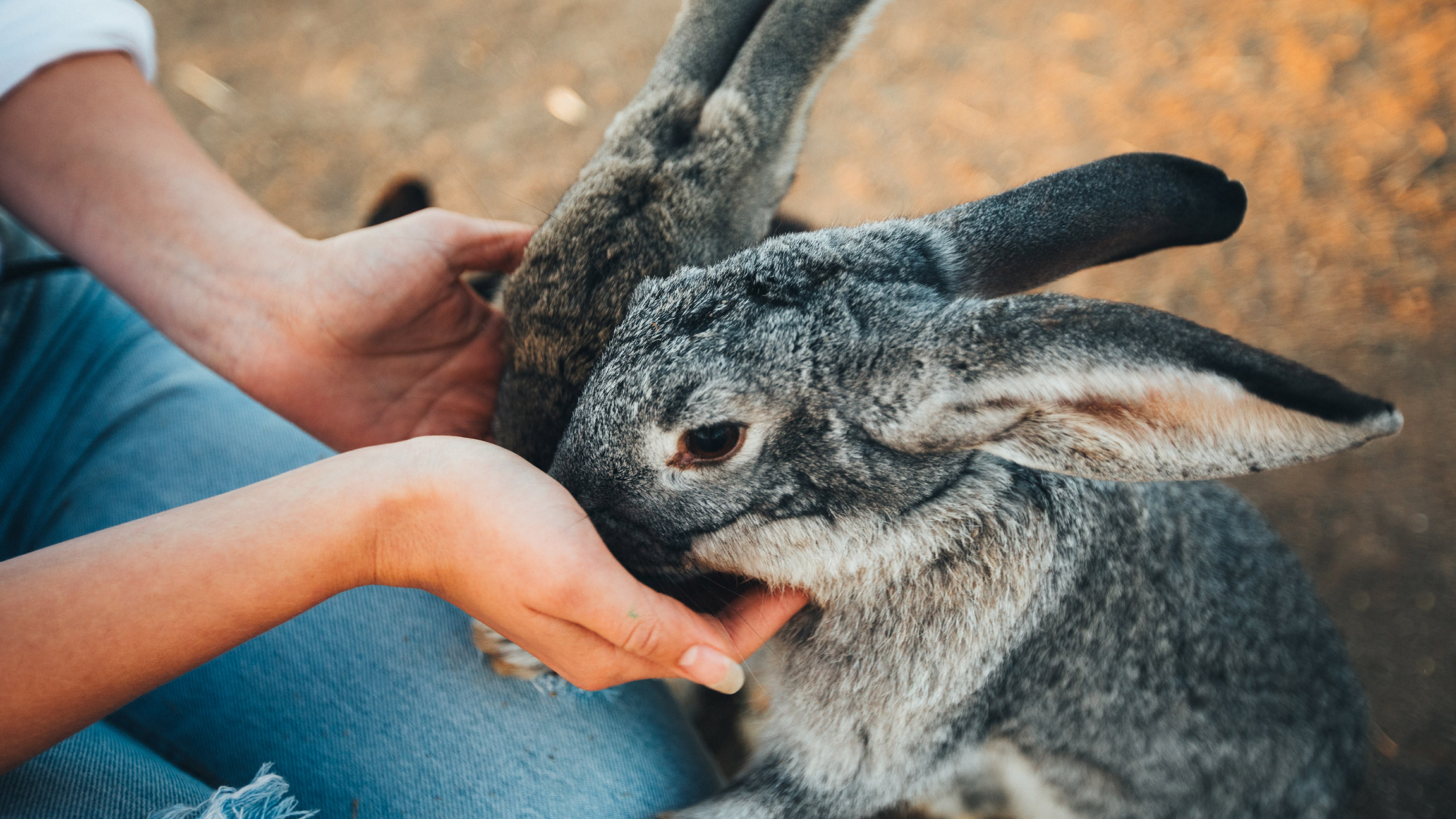
Volunteer Opportunity at Hop Haven Rabbit Shelter!
Location: Napier
Hours: Flexible, part-time, or full-time opportunities available
Are you passionate about animals and want to make a difference in the lives of rescued rabbits? Hop Haven Rabbit Shelter is looking for dedicated volunteers to join our team and help provide care to the rabbits that call our shelter home!
About the Role
As a volunteer at Hop Haven, you will assist in a range of tasks to support the daily operations of the shelter. Your role will be crucial in ensuring the health, happiness, and well-being of our furry friends.
Your tasks may include:
- Feeding and providing fresh water for the rabbits
- Cleaning cages and living areas to maintain a safe and hygienic environment
- Socializing with the rabbits to help them become more comfortable around people
- Assisting with rabbit health checks and basic grooming
- Helping with adoption events, providing information to potential adopters
- General shelter maintenance and tidying up
- Assisting in administrative tasks when needed
Why Volunteer with Us? At Hop Haven Rabbit Shelter, every day is different! The work you do will depend on various factors, such as the time of year, the number of rabbits in our care, and what needs to be done at the shelter. This means you’ll gain a wide range of experience and skills that are applicable in many animal care settings.
You’ll also have the opportunity to:
- Learn more about animal care and behavior
- Develop hands-on skills that are useful in veterinary clinics, shelters, or pet care
- Make a meaningful difference in the lives of rescued rabbits
- Be part of a supportive and passionate team of animal lovers
Who Are We Looking For? No prior experience is necessary, just a love for animals and a willingness to learn! We’re looking for people who are:
- Reliable and responsible
- Comfortable working with rabbits and other small animals
- Able to commit to at least one shift per week
- Happy to help with both hands-on animal care and general shelter tasks
How to Apply
If you're interested in becoming a volunteer at Hop Haven Rabbit Shelter, we’d love to hear from you! Please contact us at hophaven@gmail.co.nz to learn more about how you can get involved.
What is a code of conduct?
A Code of Conduct is developed by an individual organisation and often outlines, in one document, how the business maintains its ethical work practices. Examples of ethical work practices are honesty, integrity, promise-keeping, trustworthiness, loyalty, fairness, concern for others, respect for others, law-abiding, commitment to excellence, leadership, reputation, morale and accountability.
Staff are often required to read and agree to abide by the specifications of the Code of Conduct, which may outline behavioural and presentation standards for employees. Smaller organisations may not have a separate Code of Conduct. Rather, individual ethical work practices may simply be embedded into individual policies and procedures.
Here’s some more information about codes of conduct.
Reading - Pānui
Workplace Codes of Conduct: The Complete Guide
Read time: 5 mins
Article Summary: Read this article to get a really clear summary about codes of conduct in the Aotearoa - New Zealand workplace context.
Pre Read Question: Before you read think about why a code of conduct could be important for workplaces. Then as you read, decide if your ideas match what the article says.
Activity – Hei Mahi
Think about Zoe, who wants to start her own dog-walking business, or perhaps about a business that you might see yourself working in for the future. Draft a simple Code of Conduct in poster form. Use the information from the article above to help you. The idea would be that you (or Zoe!) The idea would be that you could display it on a social media account or on the wall of a shop so your customers can see your values. When you are done, post it in the forum. Don’t forget to check out and like what your classmates have done!
What are Policies and Procedures?
Policies and procedures are developed by an individual organisation or even a specific department within that organisation and usually relate to a specific topic or individual task. They provide overarching guidelines and step-by-step processes set out in a way that’s easy for staff to locate.
Policies
These are standards or regulations put in place by an organisation. They can be presented in hard or digital copy and should always be accessible within the workplace. Policies often stipulate how the workplace will be implementing and abiding by relevant legislation. For example, a workplace may have a Privacy Policy or an Anti-Discrimination / Equal Opportunity Policy. Generally, workplace policies are implemented by a set of procedures.
Examples of workplace policies that you may be required to abide by are:
- Animal welfare - includes feeding and watering, animal handling, housing setup and maintenance, exercise, and socialisation needs.
- Environmental sustainability - includes proper use and disposal of potentially hazardous substances and reducing energy/water use.
- Infection control - includes clinical waste disposal, handwashing techniques, and aseptic techniques.
- Cleaning and hygiene - includes cleaning schedules, cleaning techniques, cleaning equipment, and sanitising agents.
- Workplace health and safety - includes the duty of care for employers and employees, evacuation procedures, and hazard/risk control.
- Anti-discrimination and anti-bullying - includes the protection of employees regardless of disability, race, gender, religion, nationality, or sexual orientation.
- Privacy - includes provisions for the protection of employee and client personal information.
Procedures
Also known as Standard Operating Procedures (SOPs), these are detailed documents that outline how to safely and effectively complete a task step-by-step. SOPs are easy to follow and include details such as potential health and safety issues and control methods for minimising the risk associated with potential hazards. SOPs ensure that existing staff members are completing workplace tasks with consistency and that all new staff members are aware of organisational standards and requirements. SOPs should be readily available to all staff members and consulted when completing an unfamiliar task.
Reading - Pānui
What you need to know about policies and procedures
Read time: 5 mins
Article Summary: Here's what the New Zealand government says about policies and procedures.
Pre Read Question: Before you read what do you think is the number one reason why all businesses need policies and procedures?
Source: Business.govt.nz
Post Read Task: Now that you have read the article have you changed your number one reason for why businesses need policies and procedures? Why or why not?
Task Checklists
Checklists are used in the workplace to ensure that certain duties, such as maintenance and/or cleaning tasks, are completed as required. Task lists may be divided into separate checklists based on the frequency with which the task is required to be completed (for example, daily, weekly, or monthly lists), or they can be divided into separate room lists. For example, a veterinary clinic may have separate checklists for tasks to be completed in the surgery room, consulting room, waiting area, etc. When you are working from a checklist, you must consult your workplace SOPs to effectively complete any unfamiliar tasks. You must date and sign your name once you complete any task from a checklist so your colleagues are aware that the task has been completed for that day, week, or month. This ensures others are not wasting time by repeating cleaning or maintenance tasks.
Activity – Hei Mahi
You’ve had to leave town unexpectedly and have asked someone to look after your pet. Write a checklist for your pet sitter to make sure they do all of the things your pet needs to be happy and healthy while you are away. Be as detailed as you think your pet needs. Share your checklist in the forum. Is it similar or different to your classmates’ ones?
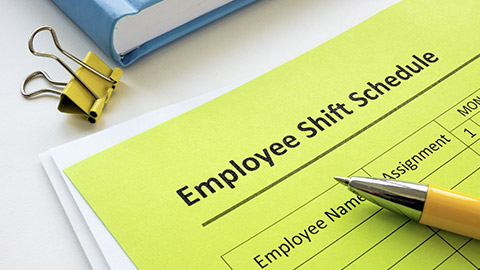
A roster is generally a list or plan of hours to be worked by each individual employee on any given day. Rosters exist to ensure an appropriate number of employees will be available for the duration of an organisation's trading hours. Rosters are generally produced by senior staff members or management in consultation with employees. It is in the best interest of management to ensure a healthy work-life balance can be maintained around an employee's work hours. Clear and detailed rosters ensure there is no confusion, and all employees will be present for their shifts. Rosters may also detail an employee's total number of hours for the period indicated. Sometimes, rosters will use the 24-hour clock, so you will need to make sure that you can understand this quickly.
Do these exercises in your head before you check your answers by clicking the + symbol.
7.30 pm
2100 hours
1 am
1445 hours
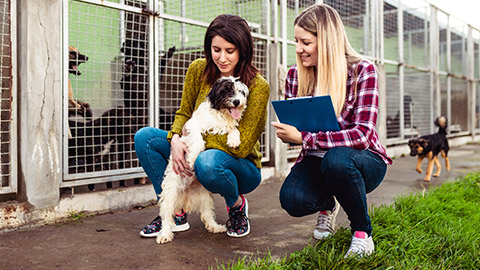
Later on in this module, you will learn more about workplace communications. It is important to familiarise yourself with your workplace policies and procedures for good communication with your employer, colleagues and clients.
There are various types of communication that you will undertake with other staff members and clients or customers.
These include:
- Face-to-face communication.
- Written correspondence such as letters, text messages or emails.
- Phone calls.
It is also important to remember that just like animals, we also communicate non-verbally with our body language. Be aware of your posture and body movements when communicating.
Teamwork is also important, especially in situations where risks or hazards are present. Maintaining open communication can assist in maintaining positive and constructive teamwork. Team work is also an important skill to highlight on your CV when applying for jobs. It’s never too early to think about updating your CV, so check out the seek.co.nz website to see what they say about the essential teamwork skills.
Reading
Teamwork skills (with 10 examples for your resumé)
Read time: 10 mins
Article Summary: This article has examples of team work skills for developing a resume.
Pre Read Question: Do you have an up to date CV? Is teamwork one of the skills that you have listed?
Source: Seek.co.nz
Post Read Task: Edit your CV to make sure that you have highlighted your team work skills.
Tip
If you are at work and see someone struggling or you have completed your required tasks, lend a hand! It will maximise your chances of promotion or moving from a volunteer to paid role.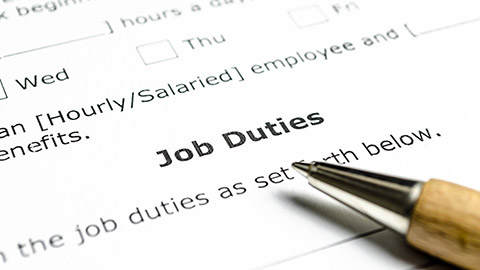
As an individual with a Certificate in Animal Care (Level 3), you will be able to go into an animal care workplace in an entry or support role. In most workplaces, your job role or title will be Animal Attendant. This does not mean you are limited to these roles; however, some workplaces may require you to do additional study to move into other positions.
The types of tasks or responsibilities you may be asked to complete include:
- Cleaning and maintenance of animal housing.
- Feeding and watering animals.
- Handling and/or restraining animals for treatment or medications.
- Exercising animals.
- Developing and implementing enrichment strategies.
- General cleaning and maintenance of the animal care facility.
- Laundry.
- Client interactions, including the admission and discharge of animals into the facility.
- Restocking, including making up chemicals or solutions.
Case Study
A typical day for Emily at the SPCA
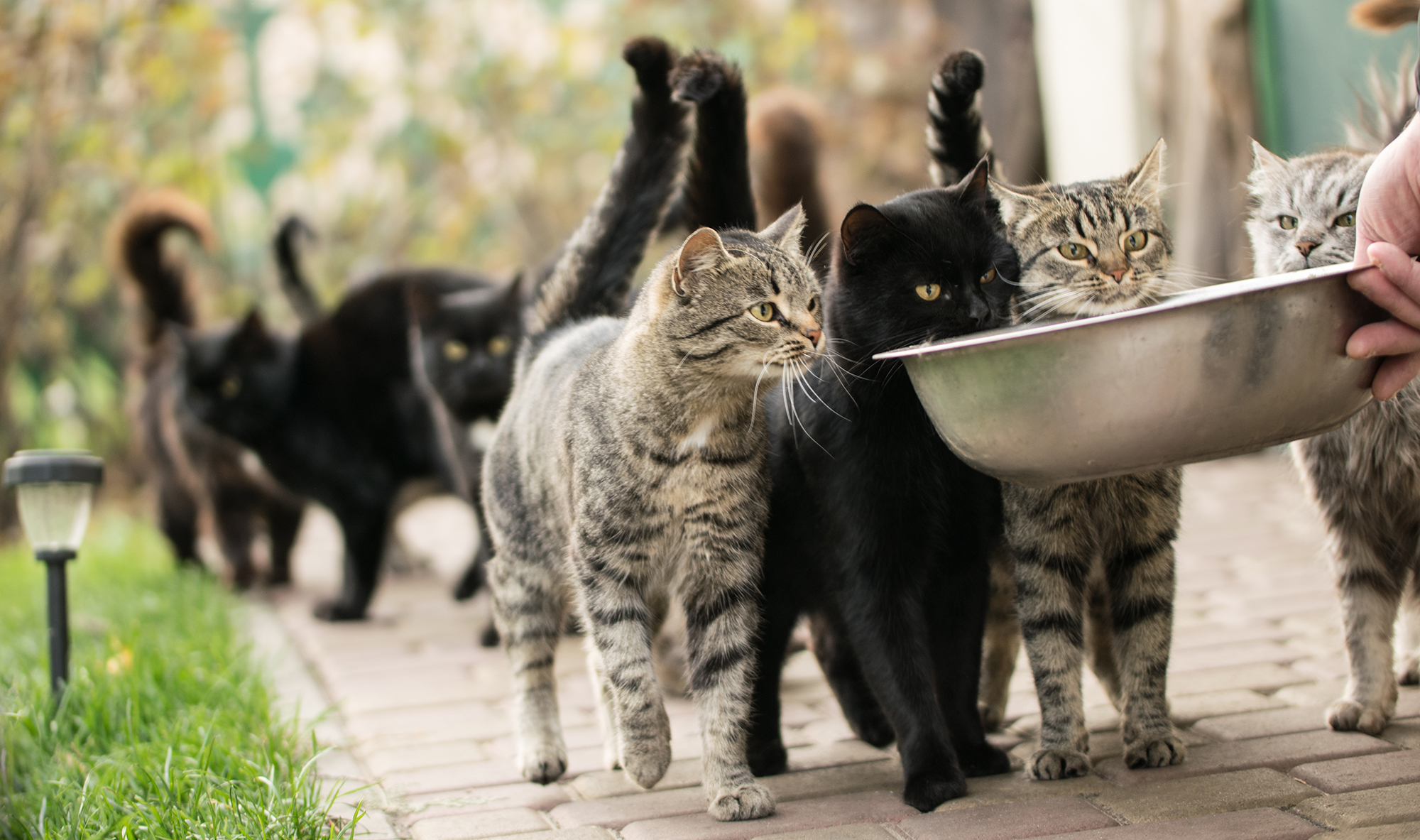
At the start of my shift, I check in first with my supervisor or manager. Once you get to know the workplace, it’s pretty easy to pick what the responsibilities are that need to be completed on a day-to-day basis, but I still check in with them to make sure there isn’t something specific that they want me to do.
From there I go around and check on each animal. Sometime there are rounds. Rounds are when you get a handover with information about each animal and its needs. For example, if they are being walked and what their temperament is like. I check each animal’s file or cage card, to ensure I have an idea of when they need to be walked, fed, or treatment is required. Each animal should have a fresh bowl of water and when required appropriate meals. While I am going around checking on each animal, I also take note of which cages require cleaning. Once my checks and/or rounds are complete, I need to go around and clean each cage according to SPCA workplace procedures.
Most SPCAs will have a schedule already worked out for staff and volunteers. For example, they may require that all animals be walked every 4 hours or once in the morning and once at night. Feeding may only be done in the morning unless stated otherwise or it may happen at midday and 8 pm before we leave. It takes a while to become familiar with the workplace policies and procedures and follow these on shift, but mostly they make really good sense. On top of exercising animals, I sometimes come up with enrichment strategies, especially for animals that are boarding.
In between cleaning the cages, exercising animals, and feeding them, l need to keep my eye on the laundry. Multi-tasking can be a helpful skill to have. If I am walking to the laundry, I’ll pop my head in and put a cycle on if there is a build-up of washing. I also need to clean animal dishes, litter trays and other items used such as kidney dishes. Sometimes I am asked to clean and pack up areas after use. This may include equipment that is used. This means I manage the waste and frequently change the bins!
At the end of my shift and throughout my shift, I keep an eye on the level of products out on the shop floor and restock anything that is getting low or becomes depleted.
Sometimes I may also have additional tasks to complete, like grooming animals.
There is always something to be done and lots of cleaning that needs to take place in animal care facilities. If I am ever unsure or run out of things to do, my manager or supervisor are both pretty helpful.
Let’s compare Emily’s day with the interview given by animal care attendant Cynthia Knight.
Watch – MĀTAKITAKI: Animal Care Attendant - A day in the life (2:07 minutes)
A look at a day in the life of animal shelter officers who work for Auckland Council
Questions
Pre-Watch Question: As you watch, compare Emily’s day at work with the animal care attendant in the video. What’s similar and what’s different between their roles? Whose day do you prefer the most? Why?
With any job, it is important to demonstrate a good work ethic. So, what does this mean? Take a moment to think about each of the seven ‘A’s of good work ethics before you click on the + signs to the right.
Positive, reacting appropriately.
Reliable. Show up and be on time.
Professional in the way you act and look.
Initiative, adding value.
Respect for others and follow the rules.
Gratitude for others, selfless.
Honesty, integrity.
Activity – Hei Mahi
How does Aroha demonstrate the seven ‘A’s? Read about her typical day below. For those of you who already work in the industry, how does this compare to your situation?
Case Study
A typical day for Aroha at work

Our shop opens at 8.30 am every day, including weekends, so I usually get up around 6 am. I bike to work because it’s close and Christchurch is pretty flat. We have a uniform, which is a smart polo shirt and shorts, and I will usually have checked the night before to see that it is clean. I don’t typically wear much make-up, but I do keep my hair tied up because it can get in the way, especially if I am in the pet-washing section of the shop.
I work different shifts, which I don’t mind, as we generally only get rostered for weekends every second or third week. My role is quite varied, sometimes I check the stock on the shelves, sometimes I am on the counter, and sometimes I am assisting customers with things like the self-service dog washing or product questions. Our customers are usually really nice to deal with and I love meeting the pets that come into the shop.
It’s a pretty good company to work and I like my colleagues. I can definitely see myself in the manager’s role here in the future.
Appearance
Your appearance is extremely important, especially when interacting with clients. All employees should follow these simple rules for personal hygiene:
- Hair should be tied back and off your face. It should be neat and tidy.
- Makeup should be kept to a minimum.
- A name badge may be required.
- Shower daily and use deodorant.
- Clothes should be neat, tidy and clean. If you are required to wear a uniform, it should be worn correctly.
- Short and clean nails. Acrylic/fake nails and nail polish rules will differ in each workplace. For hygiene and aseptic reasons, the general rule of thumb is no.
- Long, loose-fitting pants.
- Non-slip enclosed shoes.
Activity – Hei Mahi
Why is appearance so important in the animal care industry? Is it just because of looks? Post your ideas and share your industry or personal experience related to appearance in the forum.
Within the animal care industry, several common hazards can occur in the workplace. You need to know and understand what these hazards are and how to control them, so workers are not exposed to the risks from these potential hazards.
The awareness of workplace hazards and risks is an important element to any employee. Quite often, the more obvious areas of concern will have already been identified by management and/or industry advisory bodies, and these will be documented in your workplace’s Health and Safety policy. However, it is the responsibility of individual employees to be familiar with each identified hazard and the likelihood of it occurring (risk factor) and to report any instances of unsafe practice, broken machinery/equipment or poor layout of furniture/equipment. This helps to prevent near misses or injuries from occurring.
What is the difference between Hazards and Risks?
A Hazard is something that can cause you harm, for example, electricity, chemicals or an animal.
A Risk is the likelihood of that hazard occurring and also the level of severity of harm that it may cause.
In New Zealand, www.worksafe.govt.nz has provided the 4-step PLAN-DO-CHECK-ACT approach as a guideline for individuals and businesses to manage risk management.
Specific legislation relating to health and safety in the workplace will be covered in Module 2.
![[ADD IMAGE'S ALT TEXT]](/sites/default/files/Figure%201_2.png)
Activity – Hei Mahi
Let’s quickly check the difference between a hazard and a risk. For each situation below, decide if the statement describes a hazard (something that can cause harm) or a risk (the likelihood and severity of harm occurring).
H5P here
Duty of care
Employers and employees both have legal responsibilities as per Workplace Health and Safety legislation. Acts will often refer to the phrase "duty of care". This is the care owed by one person to another. Concerning hazards and risks in the workplace, a duty of care helps to ensure that hazards are identified, assessed, and controlled (hierarchy of control = elimination, substitution, engineering, administration, or personal protective equipment), and the process is reviewed regularly by applicable parties to reduce incidents.
Employer duty of care
According to the Health and Safety at Work Act 2015:
The primary duty of care is a broad, overarching duty. It includes having effective practices in place for:
- Providing and maintaining:
- a work environment that is without risk to health and safety.
- safe plant and structures.
- safe systems of work.
- adequate facilities for the welfare of workers at work.
- Safe use, handling and storage of plant, substances and structures.
- The provision of information, training, instruction or supervision that is necessary to protect people from risks to health and safety arising from the work carried out.
- Monitoring the health of workers and the conditions at the workplace to prevent illness or injury to workers arising from the work carried out.
Source: Health and safety at work » Employment New Zealand
Employee duty of care
Likewise, the Health and Safety at Work Act 2015 states that an employee must do the following:
- Take reasonable care for their own health and safety.
- Take reasonable care for the health and safety of others.
- Comply with any reasonable instructions, policies, and procedures provided by the employer or business.
Here are some Duty of Care scenarios relevant to New Zealand legislation. Who has the duty of care in each one – the employer or the employee? Think about each situation and decide your answer. Compare your thoughts with the suggested answer by clicking on the + buttons.
Scenario 1: Chemical Safety in an Animal Shelter
Context: You work at an animal shelter where various cleaning chemicals are used daily.
Situation: A new cleaning product has been introduced, but the safety data sheet (SDS) was not reviewed by the team before its use. During a cleaning session, a co-worker develops skin irritation after exposure.
The employee had the duty of care to recognise that the chemical was new and ask questions about how to handle it safely.
Scenario 2: Handling Aggressive Animals
Context: As an animal care attendant, you are responsible for handling various animals, some of which may have unpredictable behavior.
Situation: You notice a fellow employee is routinely asked to handle a large, aggressive dog without adequate training or safety measures in place. One day, the dog bites the employee, leading to an injury.
The employee has the duty of care to report the situation to management, but to also look out for the safety of the colleague by stepping in and helping or advising them not to handle the dog without supervision.
Scenario 3: Slips, Trips, and Falls
Context: The animal care facility is busy, with pets and equipment frequently moving in and out.
Situation: During a rush, a water bowl is knocked over, creating a wet floor in a high-traffic area. An employee slips on the wet floor, resulting in a sprained ankle.
The employees have the duty of care to respond to the situation by cleaning up the water immediately.
Scenario 4: Emergency Procedures
Context: You work in a veterinary clinic that handles various emergencies, including animal rescues and medical situations.
Situation: An unexpected power outage occurs during surgery, and the backup generator fails to activate. The surgery is interrupted, causing stress for the staff and jeopardizing the animal's health.
Scenario 5: Personal Protective Equipment (PPE)
Context: The pet retail store where you work has certain tasks that require the use of PPE.
Situation: Employees are instructed to wear gloves and masks when handling animals but often neglect this due to discomfort, risking exposure to allergens and infections.
The employees have the duty of care to recognise that PPE is there to keep them safe and that wearing it is not option. If the PPE is not comfortable or fits poorly they should advise management.
Scenario 6: Reporting Incidents
Context: As part of your role, you are required to report any near misses or incidents.
Situation: An employee witnesses a co-worker almost get injured when an unsecure gate swings open, but they decide not to report it, thinking it wasn’t serious.
Animal Handling Hazards
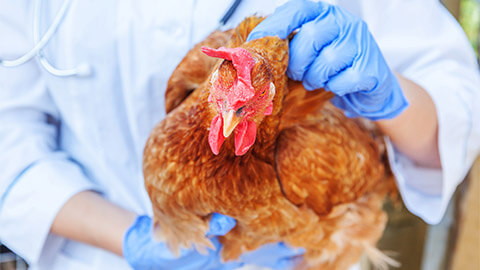
Animal handling presents a very likely risk of injury and must be undertaken with due caution and by following set procedures.
Always ensure you are adequately prepared before handling animals: close doors, remove obstacles and secure other animals. Observe the behaviour and temperament of the animal before approaching to ascertain if it is displaying signs of stress, fear or aggression. Use appropriate restraint techniques and equipment. Before and after handling animals, it is best practice to practice effective personal hygiene (handwashing). There is a whole module around handling animals for you to look forward to so we are only taking a quick look at this now.
Common Injuries/Conditions
Common injuries/conditions (hazards) that can occur as a result of animal handling include:
- Bites - most animals can bite, some worse than others.
- Scratches - animals with sharp claws can inflict quite serious scratches to your skin if they are scared or trying to flee.
- Kicks, crush injuries, head butting/charging, and trampling are common when handling large animals such as livestock or horses.
- Zoonotic diseases - diseases that can be transmitted from animals to humans if proper precautions are not taken.
In addition to these injuries, it is important to consider exposure to some bodily fluids as they can also cause illness and potential infection if proper hygiene has not been carried out. Bodily fluids from animals may include:
- Blood
- Faeces
- Vomit
- Urine
- Saliva
- Placenta
Zoonotic Diseases
A zoonosis is an infectious disease caused by bacteria, viruses and parasites that spread between animals and humans. We’ll look more closely at symptoms and treatments for these in another module. In the meantime, here’s a list of the most common ones in case you hear staff talking about them when you are in the workplace.
Types of Zoonotic Diseases
Visceral larval migrans (roundworm)
Occurs in dogs, cats and other animals when roundworm larvae migrate to and mature in tissue rather than the gastrointestinal tract. Causes damage to tissues, allergic reactions, and visual and/or neurological damage. Prevented by deworming pets and maintaining hygiene.
Scabies
Mainly occurs in dogs, pigs and humans. Contracted via direct contact with an infected animal. Causes itchy red dots on the skin from burrowing mites. Prevented by maintaining hygiene and treating infected animals.
Hydatid tapeworm
Occurs in humans through contact with infected dog and cat faeces. Causes cysts to develop in the lungs, liver, and brain - these cysts can be 50cm in diameter. During surgical removal, cysts may burst and form hundreds of new cysts. Prevented by maintaining proper hygiene, wearing gloves, deworming animals for hydatid tapeworm and not feeding raw liver, lungs or other organs of sheep to animals.
Ringworm
Transmitted from cats, dogs and horses, is not a worm but a fungal infection of the top layers of the skin and hair. The kinds of fungi that cause ringworm are called Dermatophytes. While generally harmless, ringworm is highly contagious to humans, especially to children, the elderly and anyone with a compromised immune system.
Toxoplasmosis
Toxoplasmosis is a disease caused by the parasite Toxoplasma Gondii, which can be found in garden soil and raw meat. Cats can get toxoplasma infection by killing and eating infected prey. When pregnant women are exposed, the following foetal defects may occur; foetal retardation, anaemia, hydrocephalus (water on the brain) and miscarriage. Males and non-pregnant females may experience flu-like symptoms when infected. It is prevented by cleaning up cat faeces immediately while wearing gloves, as transmission through infected cat faeces is most common (ideally, pregnant women should avoid cleaning up cat faeces altogether). Avoid handling raw or uncooked meat, peel and wash home-grown vegetables, wear gloves when gardening and cleaning up sandpits, and maintain hygiene.
Salmonella
Salmonella is a large family of bacteria. Reptiles and other animals can carry a range of Salmonella in their intestines. When ingested by humans, this bacterium has the potential to cause severe intestinal disease. Good personal hygiene measures, including effective and thorough hand washing along with the use of personal protective equipment such as disposable gloves, will help to reduce the likelihood of infection.
Staphylococcus
Staphylococcus is caused by Staphylococcus bacteria. Generally, Staphylococcus bacteria can live on the skin of mice and other rodents in small numbers without causing any disease in healthy animals. However, when a mouse has a compromised immune system through an injury or an underlying illness, the Staphylococcus bacteria can grow in large numbers and cause pain and discomfort to the rodent through skin sores and general ill thrift. Human handlers must ensure quarantine procedures are used to avoid contracting the skin bacteria from infected rodents. As mentioned above, we’ll look at these diseases in more detail later on in the learning. Before we move on though let’s do a short recap activity. Type the name of the correct disease in the blank spaces below. Make sure you get the correct spelling!
H5P here
Treating bites and scratches
Bites and scratches not only cause pain and discomfort, but there is also the risk of wound infection, contracting a zoonotic disease or, in the cases of severe injury, surgical intervention. Animals are creatures of habit. If you are working in an animal care facility caring for an animal, the chances are that you have disrupted their routine, causing anxiety and possibly fear-driven behaviour. Even the most placid animals may become frightened by strange people and different noises.
Injury
In the event of an injury, it is very important to follow these steps to avoid further injury to both the handler and the animal. However, the steps are all jumbled up. Have a go at putting them in the correct order.
- Secure the animal (or get someone with the correct knowledge to assist if you are unable to do this).
- Bathe the affected area with antiseptic (such as iodine).
- Apply basic first aid, such as dressings, to control bleeding.
- Notify your supervisor and complete a workplace incident report form.
- Seek medical advice for more serious injuries.
Psychological hazards
In the animal care industry, you may come across situations that cause psychological distress or even damage. Some of these situations may include:
- Overtime and working long hours.
- Shift work.
- Dealing with difficult and/or grieving clients.
- Animal suffering.
- Euthanasia of sick and sometimes healthy animals.
- Heavy workloads.
- Conflicts with colleagues.
- Workplace bullying/harassment.
The above factors may contribute to causing work-related stress. Work-related stress is a significant health and safety issue and may have temporary or lasting effects on your mental health and physical well-being. Depression, anxiety, a drop in productivity, headaches, difficulty sleeping, lethargy and an increase in sick days may all be signs of work-related stress. If you are experiencing any of the above symptoms, you are urged to seek assistance from your supervisor, human resources manager, doctor or psychologist.

Resources for Managing Stress
This website is a good starting point for getting some tips if you are feeling stressed: Stress at work | Healthify
Learning some relaxation techniques can be a good way for managing stress. Download this poster and keep it by your desk to remind you to take care of yourself! te-kete-fatigue-relaxation.pdf (healthify.nz)

Ergonomic hazards
Ergonomic hazards can occur as a result of:
- Incorrect lifting technique - resulting in back strain. Ensure you utilise the correct lifting technique and seek assistance when attempting to lift heavy items (including heavy animals).
- Incorrect sitting posture - Resulting in neck strain, eye strain, and headaches. Ensure you have your chair, desk and computer set up correctly for your height and desk layout if you have a desk job.
- Repetitive actions - resulting in Carpal Tunnel Syndrome (a disorder in the wrist and hand). Ensure you take regular breaks and wear appropriate protective gear.
Manual Handling
Manual handling is a part of every job; however, in a veterinary clinic, you may do more than others. Manual handling tasks could include:
- Lifting animals.
- Replenishing stocks of tinned and dry food.
- Stacking boxes.
At times, your work tasks may involve bending, stretching, twisting, or working with heavy loads. All of these increase the risk of manual handling injuries if the tasks are not performed correctly. Several injuries can be sustained if not living correctly. Some of these may include:
- Sprains to muscles, ligaments, and tendons.
- Back injuries with the inclusion of damage to nerves, discs and tendons.
- Joint and bone injuries, including shoulder, wrist, knees, ankles, elbows, hands and feet.
Correct lifting techniques
Ensure you keep your back straight at all times, unlike the following diagram:
Animals can come in all sizes. You may have to handle a very large dog. Or you may have to carry heavy metal cages. The following video (made in the USA sorry!), takes you through the steps for safe lifting.
Watch - Mātakitaki (Video):Video Title: Safe Lifting The Fundamentals of Ergonomics
Watch Time: 6:23
Video Summary: A step by step look at safe lifting practices.
Pre Watch Question: Have you been taught how to lift safely? Compare what you think you know with the content of the video.
Source:
Post Watch Task: Practice on something at home to make sure you have the techniques correct. You could ask a family member to check how well you are doing it.
Physical Hazards
There are physical hazards that can present themselves within the animal care industry that you will need to be mindful of, which can help you take extra precautions.
The following table illustrates the common physical hazards that may be present in the animal care environment along with a preventative and suggested Personal Protective Equipment (PPE) to minimise the risk.
| Physical Hazard | Cause of Hazard | Possible Injury or Illness | Preventative or PPE |
|---|---|---|---|
| Noise |
|
Sensitivity in ears, possible tinnitus, headaches, hearing loss. |
|
| Vibration | Certain hand tools, such as clippers. | May cause carpal tunnel syndrome if used excessively. | Use personal protective equipment and take regular breaks to reduce this risk. |
| Electrical |
|
Electrocution |
|
| Security | Violent or aggressive encounters with people. | Physical violence |
|
| Slips, Trips and Falls |
|
|
|
| Heat |
|
|
|
| Ocular (eyes) |
|
Long-term eye damage |
|
| Gravity |
|
|
|
Chemical Hazards (Hazardous Substances)
Hazardous substances that have the potential to cause harm to the body and may also endanger the environment if not disposed of correctly can be found in the workplace in several physical forms, such as:
- Fumes
- Smoke
- Mist
- Gases
- Vapours
- Liquids
The following table illustrates the chemical hazard categories along with the damage that can be inflicted with exposure.
| Chemical Hazard Category | Consequences of Exposure |
|---|---|
| Toxic and/or corrosive/irritant chemicals | May cause damage to the environment and also human skin (if in contact) or body (if ingested or inhaled). For example, undiluted disinfectants or euthanasia drugs containing anaesthetic. |
| Carcinogens | May cause cancer if prolonged, unprotected exposure is allowed. For example, tissue specimen fixatives like Formalin. |
| Medications |
Controlled drugs have a high risk of abuse or addiction. For example, analgesics (pain killers) such as Butorphanol, Methadone and Buprenorphine. If PPE is not worn, some medications may be absorbed into the skin. |
| Flammables/Explosives | Can immediately injure people and animals and also damage property if uncontrollably released and/or ignited. Examples include Liquid Petroleum Gas (LPG), gasoline (petrol), and oxygen. |
Ensure that you are aware of the risks associated with the chemicals you are using in your workplace.
Supervisors and safety data sheets should be consulted as necessary, particularly with the arrival of new chemicals. Personal protective equipment MUST be used if recommended by a supervisor, policy/procedure and/or safety data sheet.
Hazardous substances may enter the body in the following ways:
- Ingestion - eating or drinking the substance.
- Inhalation – breathing in fumes, vapours, mists and dust.
- Absorption - chemical contact with mucous membranes, eyes, and skin.
- Parenteral - administration by injection, either accidental or intentional.
People will be affected by contact with hazardous substances to a greater or lesser degree depending on:
- the toxicity of the substance, amount of substance taken into the body, duration of exposure to the
- substance and individual biological and physiological differences (for example, age, weight, metabolism,
- immune function and pregnancy).
Safety Data Sheets
Documents that provide critical information about hazardous chemicals are known as Safety Data Sheets (SDS).
In New Zealand, manufacturers and importers of hazardous chemicals must prepare an SDS for each product and make this readily available. Workplaces must keep copies of relevant SDSs in a readily accessible location for all employees who may require them. Your workplace will potentially have these in a manual or computer system.
Note: SDSs are regularly updated, and workplaces must check for any updates on a routine basis and download/print out the correct version for their manual.
These documents include:
- The chemical's identity and ingredients.
- Health and physical hazards.
- Safe handling and storage procedures.
- Emergency procedures.
- Disposal considerations.
Worksafe (www.worksafe.govt.nz) has provided a document for businesses, Safety datasheets in the workplace – quick guide. This contains examples of SDS – check it out here: Safety data sheets | WorkSafe
There is a webinar about SDS in the Self-directed Learning Section which you might like to watch, especially if you are already working in an environment with hazardous chemicals.
Safe Storage and Handling
Hazardous substances must be stored securely and labelled clearly. A number of the substances used in veterinary practice must be kept in locked storage and accessed only by veterinary practitioners. They may include medications and dangerous drugs.
Some medications that may be deemed as hazardous include animal medications such as:
- Anaesthetics
- Chemotherapy drugs
Your clinic will have policies and procedures related to the storage and handling of dangerous chemicals and drugs, and you should ensure you know what these are and the level of responsibility you have for handling them. Some chemicals that you are likely to come into contact with within animal care include:
- Sterilising chemicals, including disinfectants.
- Cleaning products, including detergents.
- Solvents.
Hazards from Machinery and Equipment
Inevitably, hazards do arise in the workplace environment. The use of equipment and machinery is a high consideration. Some examples (but are not limited to) include:
| Machinery | Equipment |
|---|---|
| X-ray machine | Surgical equipment |
| Moving parts from machinery | Needles |
| Anaesthesia machine | Microscopes |
| Suction machines | Catheters |
Controllers of the equipment, machinery, appliances or substances used in the workplace also have legal responsibilities. Controllers of the equipment may include specialist contractors handling the installation or decommissioning of equipment in the workplace. Regulations stipulate the risk management requirements with which the contractor must comply.
Any equipment which may affect the health and safety of the public is also the responsibility of the owner as stipulated by legislation.
Essentially, any other personnel required in the work environment has a responsibility to take reasonable care for their health and safety, as well as all other personnel in the workplace. To achieve this, they will need to comply with any reasonable instruction given by the employer/PCBU and ensure that their actions or omissions do not adversely affect the health and safety of any personnel in the workplace.
Radiation Hazards
UV Radiation
Otherwise known as sunburn. May cause skin cancer.
Prevention methods for sunburn include covering all exposed areas of the body by wearing:
- long sleeve shirts and full-length pants to cover all exposed areas of the body.
- a wide-brimmed hat.
- sunscreen with a sun protector factor of SPF30+.
- UV protective sunglasses.
Please note: Glass, windows, and clouds do not protect you from UV radiation. You can still get burnt on overcast days.
Many roles in the animal care industry involve long hours working outside. Protecting yourself from sunburn and skin cancer should be part of your daily routine.
Watch - Mātakitaki: How to Apply Sunscreen (0:50 minutes)
X-rays
Only appropriately trained and qualified staff with a current radiography license should operate the machinery (in most cases, this is only for veterinarians). They have specific instructions to follow and must wear personal protective equipment.
Repeated exposure of human tissues to invisible X-rays may cause:
- tumour development.
- cataracts.
- foetal damage.
- bone marrow damage.
- cutaneous burns.
- blindness.
- infertility.
Be aware of this hazard. However, as you will not be required to operate this type of equipment, it is a very low risk to you.
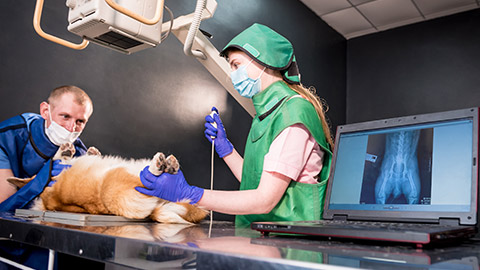
Clinical Waste/ Biological Hazards
Clinical waste is the by-products of medical, nursing, dental, veterinary, pharmaceutical or similar professions and may consist of human or animal tissue, blood, body fluids, excretion, drugs, swabs, dressings, syringes, needles and other sharp instruments.
These products may pose a hazard to people coming into contact with them due to the risk of physical injury (cutting oneself with a sharp implement) or infection (from contaminated sources).
Storage, treatment and disposal
Producers of clinical waste should ensure that such waste is stored, treated and disposed of as per the following conditions.
- Stored in a leak-proof container with a securely fitting lid.
- Stored in a weatherproof, secure location.
- Isolated from other wastes.
- Stored in a manner that poses no threat to health, safety or the environment.
- Clearly labelled as containing clinical or biological waste.
- In the case of accidental spillage, all necessary equipment to clean and disinfect the area should be readily available. This may include a spill kit.
- Disposed of as soon as reasonably possible as per legislative or regulatory guidelines. For example, specifically licensed contractors may be required to pick up clinic waste, or local government (councils) may have stipulations regarding the disposal of animal waste and carcasses.
- If any other waste is mixed with clinical waste, that waste is also to be treated as clinical waste.
The following symbol warns of a potential biological hazard that may be associated with clinical waste. This symbol/warning sign might be displayed on disposal receptacles like sharps containers or certain bins.
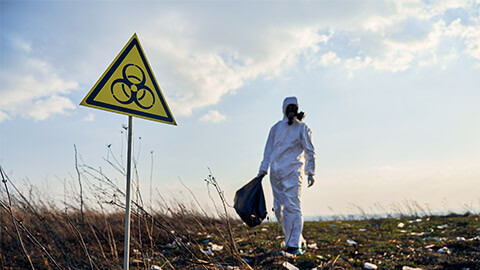
Sharps
Sharps can be defined as objects or devices having sharp points capable of cutting or piercing the skin, causing needle stick injuries and infection. This includes but is not limited to, hypodermic needles, scalpels, syringes, broken glass ampoules and/or bottles and scissors.
Sharps must be disposed of in special containers that are secure and appropriately labelled. They are then collected by or sent to licensed collection agencies for appropriate disposal. Sharps containers are variably sized yellow plastic containers that are:
- puncture-resistant, leak-proof, shatter-proof and able to withstand heavy handling.
- clearly labelled as clinical waste and display the biohazard symbol.
- able to be sealed when ready for disposal and capable of being handled without danger of the contents spilling.
The following images are examples of sharps containers that are commonly used.
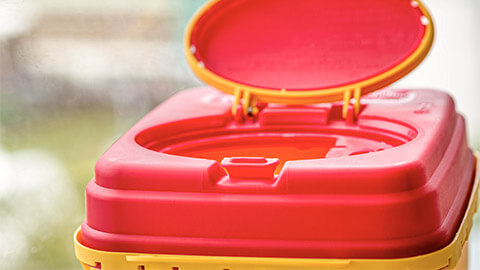

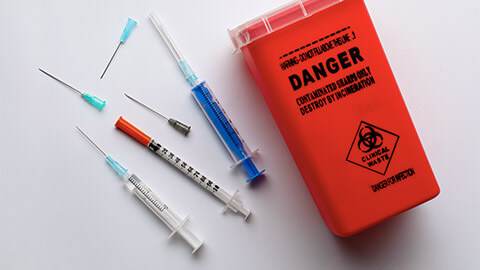
Handling sharps should be part of your training if they are something that is used in your workplace. There are a number of different types of sharps receptacles (bins), but the following video give you a good explanation of how they are set up and how they work to protect staff from unexpected injury.
Watch - Mātakitaki (Video):
Video Title: Instructions for Use Model I and II Sharps Waste Container
Watch Time: 2:38 mins
Assess Risks
Assessing risk means determining the likelihood of the risk occurring and, if it does, what the severity level may be. The risk matrix below provides a visual reference of how risk likelihood and severity interact.
A determination of the likelihood of a hazard occurring is made, and then a determination of the accompanying risk factor is also made. The two items will intersect within the matrix, and depending on the colour code of the intersecting square, the hazard is determined to be either High Risk (Red), Medium Risk (Orange), or Low Risk (Yellow). Hazards are ranked using this matrix in their initial instance; however, the risk factor can be reduced if control measures are utilized.
For example, the hazard of being bitten by a dog may initially be a Remote likelihood with a Major severity factor. However, the risk factor can be lowered to Extremely Remote likelihood if proper training is initiated for animal handlers, and the severity factor can be reduced to Minor if personal protective equipment is utilized.
Control Risks
The next step is to follow the Hierarchy of Controls to select the best method of eliminating or reducing risk. One or more of these control measures should be applied to each hazard to reduce the likelihood and/or severity of an injury occurring.
The Hierarchy of Controls:
- Elimination
- Substitution
- Engineering Controls
- Administrative Controls
- PPE
Click the labels or (+) symbols to read more about each of these controls.
Report incidents and injuries to supervisor
Whenever you sustain an injury or you observe a near miss (see below for definition) in the workplace, then it must be reported. This could be to the owner of the practice, the business manager or the Health and Safety Officer (if your workplace has one).
When you identify a hazard, you are required to complete an incident/*near miss reporting form and report it to the appropriate person.
- The employee is to complete all required fields on the form.
- Once the incident/*near miss report is completed, the workplace’s manager and/ or senior supervisor will need to receive a copy of that report.
- This report must then be actioned on as per the workplace's policies and procedures.
* A near miss is defined as any occurrence that might have led to an injury or illness to people, danger to health and/or damage to property or the environment.
We’ll dive deeper into Workplace Health and Safety in Module 2
Case Study
A typical workday for Caleb.
As a dog groomer, my day starts early in the morning. The first thing I do is check the appointment schedule to see which dogs I'll be working with throughout the day. Each dog is unique, with its own temperament and grooming needs, so I must be mindful of their individual requirements.
Safety is a top priority in our shop, and I make sure to inspect all grooming equipment before starting. Sharp scissors, clippers, and grooming tables can pose hazards if not handled carefully, so I ensure they are in perfect working condition. I also double-check that the grooming area is clean and free from any potential tripping hazards.
When it's time to start grooming, I approach each dog with patience and care. Some dogs may be anxious or nervous, so I use soothing techniques to calm them down. I handle them gently and securely to avoid any accidental injuries. Ensuring their safety and comfort is paramount, and I always keep an eye on their body language to gauge their stress levels.
While grooming, I'm careful with the handling of sharp grooming tools and hot dryers to prevent any accidents. I pay close attention to the specific instructions from the pet owners, whether it's a specific haircut style or any skin conditions that need special care.
Throughout the day, I maintain a clean and organised workspace, disinfecting tools and surfaces regularly to prevent the spread of germs and ensure a hygienic environment for the dogs and my colleagues.
Interacting with pet owners is another crucial part of my job. I provide updates on their pets' progress and address any concerns they may have. Effective communication helps build trust and ensures that the grooming process meets their expectations.
At the end of the day, I reflect on the satisfaction of transforming shaggy puppers into clean and happy dogs. It's a rewarding job, but it requires constant vigilance and care to ensure the safety and well-being of the dogs in my care.
Activity – Hei Mahi
What are some of the risks and hazards that Caleb has to be mindful of every day? Make a list and give each one a rating using the hazard matrix above. Then, come up with a list of ways that he can eliminate or minimise each risk or hazard. Share your findings in the forum.
Maintaining a clean, hygienic workplace is important to prevent the spread of infectious diseases. In the animal care industry, this helps to protect the animals you work with and reduces the risk to yourself and others from potentially zoonotic diseases. A dirty workplace also looks unprofessional to customers and may prevent them from returning in the future.
In addition to this, regular cleaning helps you to identify damage to animal housing and equipment and get it fixed early before it causes injury or is beyond repair. Regular cleaning also makes cleaning easier. Leaving something for a long time to clean makes cleaning it more difficult when the task eventually gets done.
There are some differences between cleaning and sanitising.
- Cleaning – the physical removal of visible contamination, i.e. rubbish, faeces, grime, and dirt.
- This process often includes the use of water and detergent.
- Sanitising – the killing of bacteria using heat and/or chemicals.
Cleaning schedules
What areas are required to be cleaned, and when?
- Surfaces should be wiped over to remove dirt and possible contamination - after each use.
- Holding cages and runs that are currently in use should be thoroughly cleaned daily and spot-cleaned as required to remove additional faeces, vomit, and spilled food.
- Bedding, bowls, toys, and other accessories should be cleaned after each use.
- Equipment used during the treatment or handling of animals must be cleaned and sanitised - after each use.
- Hands should be washed after each contact with potential sources of contamination.
- Floors should be mopped regularly, at least daily, and spot-cleaned as required.
- Bins should be emptied daily and additionally as required if they are full.
- Drains should be cleaned weekly.
- Cleaning equipment, such as mops, buckets, and washing machines, should be cleaned regularly.
- Scrub tops, gowns, and/or work clothes should be washed regularly and changed or removed when entering/exiting 'controlled' areas (such as surgical suites and isolation wards).
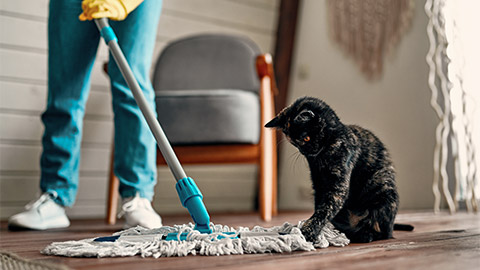
Most workplaces will have documented cleaning schedules that form part of the policies and procedures manual/ system. A cleaning schedule and the policy/procedure that it is linked to will normally outline the following information:
- Areas to be cleaned.
- Equipment required.
- Cleaning techniques.
- Personal protective equipment (PPE) required.
- Health and safety information related to particular cleaning processes, products, or equipment.
- Frequency of cleaning required.
- Checklists for recording when cleaning has been completed.
Cleaning processes
Basic Cleaning
Waste removal and wiping/scrubbing with water and mild detergent will remove dirt and grime from a surface or environment.
Examples of detergents include:
- Dishwashing liquid.
- Floor cleaner.
- Spray and wipe sprays (unless specifically labelled as a disinfectant).
- Laundry detergent.
Scrubbing prevents a biofilm, which, if present, can create a barrier that protects microorganisms from physical removal or disinfection. Different areas may require different cleaning strategies depending on the nature of the surface and its use.
Sanitising
Chemical agents that can be applied to inanimate objects that cause the destruction or inhibition of most microorganisms are known as disinfectants.
Examples of disinfectants are:
- Chlorine-based (bleach).
- Solutions with Quaternary Ammonium Compounds (Dettol and wet wipes).
- Alcohol-based solutions at least 70% concentration (hand sanitisers).
- Povidone-iodine topical solutions (Betadine).
As disinfectants are often highly corrosive or carcinogenic, routine use in low-risk areas may not be recommended. This is primarily due to the risk of un-targeted use of disinfectants, possibly contributing to the development of microbial resistance.
A commonly used safe disinfect is F10 (quaternary ammonium and biguanide compound), which is effective against a range of common viruses, bacteria, spores and fungi, including Parvovirus. You can read more about F10 here: F10® SC Veterinary Disinfectant – Product Information – F10 Products
Low-risk areas may include:
- Holding cages/runs for animals with known vaccination/health history.
- Reception areas.
- Outdoor areas.
Ensure you are familiar with the safety recommendations of any potentially hazardous product before using it. If the surface or equipment that you are cleaning is related to an animal of unknown health status, a broad-spectrum disinfectant should be used.
If the animal has a diagnosed illness, a disinfectant known to be effective against the pathogen identified should be used. Remember to ensure that disinfectants do not come into direct contact with animals or their food/water, and ensure surfaces and utensils are thoroughly dried before returning the animal to the area.
Sanitising can also be achieved through the application of heat. The use of autoclaves (industrial sterilising machines) to sanitise/sterilise caging, water bottles, and feeding bowls, as well as utensils, might be standard practice in animal care facilities where infection and biosecurity is a high risk, like veterinary hospitals or scientific laboratories.
Disposing of hazardous waste
In the animal care industry, you will come across many forms of waste, some of which may be hazardous to your health. For example:
Animal Waste
Biological in nature and with the potential to cause harm by acting as a pathological waste while undergoing decomposition. Examples include the following (assuming that the items are not infectious or contaminated):
- Animal carcasses, limbs, and tissue
- Used animal bedding and leftover food items
- Faeces
When disposing of these items, you must not mix non-compatible waste items with animal waste, as they must be separate. Avoid the use of plastic bags (unless necessary). Ensure that bins are not too heavy.
Small animal carcasses can be sent to a general landfill (the tip), but always check with your local council facility first. Some councils have limitations, such as certain days for drop-off and size restrictions. The council may offer a pick-up service for larger animals.
Chemical Waste
Generated from the use of chemicals for medical and or cleaning purposes, has the potential to cause injury or illness if spilled on the skin, inhaled, or swallowed. Chemical waste is divided into two categories relating to its disposal:
- Sewerable - items that can be deposited into drains/sewers. These usually include most cleaning (detergent)/ disinfecting agents as long as they have been sufficiently diluted with water.
- Non-sewerable - certain liquids and solids must be disposed of in specific ways as they might be toxic to the environment.
Refer to the applicable Safety Data Sheet (SDS) for specific information about each type of chemical that you are using before disposing of any chemical waste. Ensure you thoroughly rinse out any empty bottles or containers and dispose of them as directed. Never re-purpose a chemical container for any other type of product.
Clinical Waste
Medical/biological waste that is potentially infectious or contaminated has the potential to cause illness as a pathological substance or can be a host/carrier of a disease. Examples include:
- Sharps
- Pharmaceuticals
- Fixed tissue/ histology sections
- Infectious or contaminated carcasses, cage linings, or faeces
This type of waste must be placed into an appropriate container and arranged to be collected for disposal by a licensed waste transporter. It will be disposed of in the safest and least harmful way and is generally incinerated at a licensed facility. Similarly, medical sharp waste (syringes and needles) must be placed in a tamper-proof container that is suitably identified as containing sharps or clinical waste and then transported to or picked up by a licensed facility for safe disposal.
There is a very detailed instructional video on cleaning in an animal hospital in the Self-directed Learning section which you might like to watch.
Activity – Hei Mahi
The learning so far about cleaning has been focused on the animal care industry workplace. What can Kai implement at home in caring for their two rabbits, Freya and Ravenna, to make sure they stay happy and healthy? Look at Kai’s set-up for their rabbits and make some suggestions in the forum.
Case Study
Cleaning for pets at home
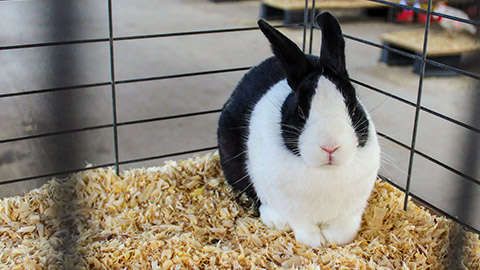
Freya and Ravenna are indoor rabbits. I have a small hutch for them, which is in the laundry at my house. They free-range the house during the day and put themselves to bed mid-evening. I don’t have a lot of room for a big cage, so the one I use is a small wood and wire one I got from the pet store. It has a collection tray for waste underneath it, which I change when it looks dirty or starts to smell. I keep lots of hay on the bottom of the cage so that their feet can stay off the wires as much as possible.
Topic Summary
In this topic we have looked at:
- workplaces and types of jobs in the animal care sector
- Codes of Conduct, policies and procedures, and roles and responsibilities
- Work conditions and ethics
- Potential hazards you might come across while working in an animal care environment
- Clean environments
Take a moment to check your learning progress by completing the following activity.
Now let’s take a look at a really important topic: communication or whakawhitiwhiti.
